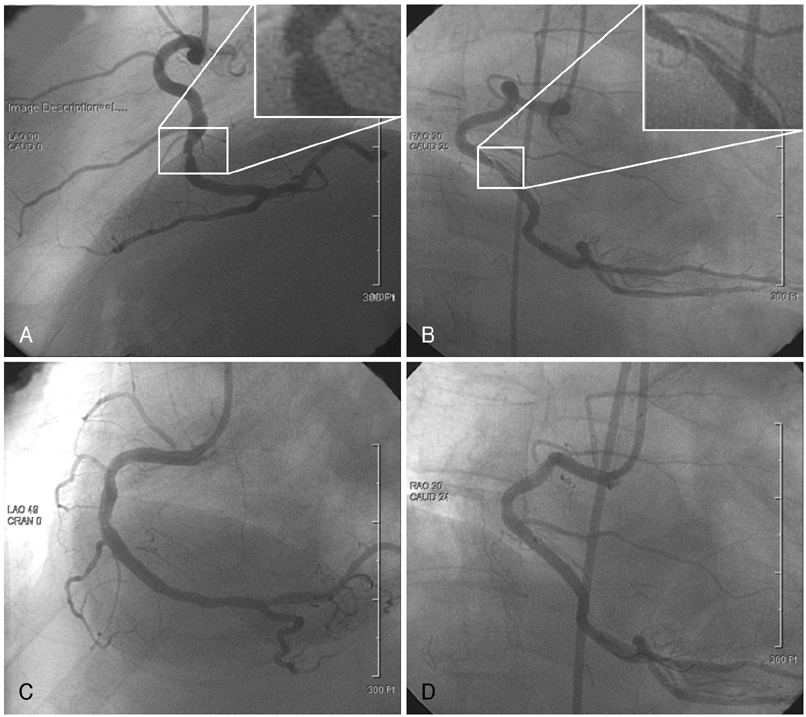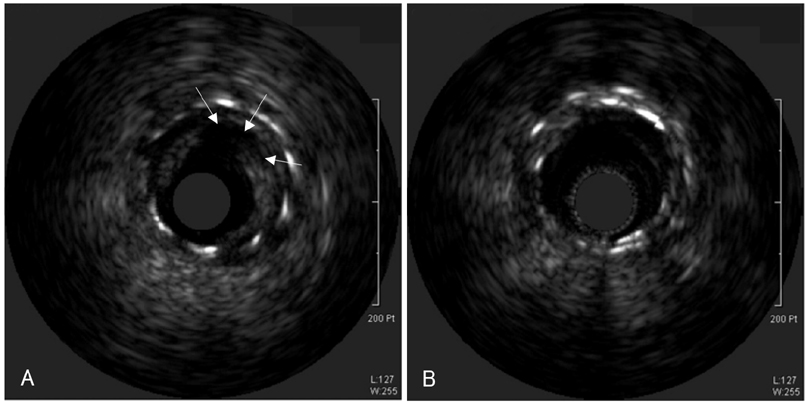Korean Circ J.
2008 Aug;38(8):432-435. 10.4070/kcj.2008.38.8.432.
A Case of In-Stent Plaque Rupture Presenting as an Acute Myocardial Infarction
- Affiliations
-
- 1Department of Internal Medicine and Ewha Medical Research Institute, School of Medicine, Ewha Womans University, Seoul, Korea. pseongh@ewha.ac.kr
- KMID: 2225764
- DOI: http://doi.org/10.4070/kcj.2008.38.8.432
Abstract
- In-stent atheromatous plaque rupture is a very rare event. A 51-year-old man presented with an acute inferior myocardial infarction 9 years after bare-metal stent implantation in the mid-portion of right coronary artery. After thrombolytic therapy, coronary angiography and intravascular ultrasound (IVUS) revealed a ruptured plaque at the mid portion of the stented segment.
Keyword
MeSH Terms
Figure
Reference
-
1. Weintraub WS. The pathophysiology and burden of restenosis. Am J Cardiol. 2007. 100:3K–9K.2. Forrester JS. Toward understanding the evolution of plaque rupture: correlating vascular pathology with clinical outcomes. J Am Coll Cardiol. 2003. 42:1566–1568.3. Hong BK, Cho SY, Jang YS, et al. Intravascular ultrasound imaging in patient with acute myocardial infarction. Korean Circ J. 1998. 28:931–938.4. Okura H, Taguchi H, Kubo T, et al. Atherosclerotic plaque with ultrasonic attenuation affects coronary reflow and infarct size in patients with acute coronary syndrome: an intravascular ultrasound study. Circ J. 2007. 71:648–653.5. Hur SH, Hassan AH, Rekhi R, et al. Serial intravascular ultrasonic study of outcomes of coronary culprit lesions with plaque rupture following bare metal stent implantation in patients with angina pectoris. Am J Cardiol. 2007. 99:1394–1398.6. Hong YJ, Jeong MH, Hyun DW, et al. Impact of preinterventional arterial remodeling on in-stent neointimal hyperplasia and in-stent restenosis after coronary stent implantation. Circ J. 2005. 69:414–419.7. Hoffmann R, Mintz GS, Dussaillant GR, et al. Patterns and mechanisms of in-stent restenosis: a serial intravascular ultrasound study. Circulation. 1996. 94:1247–1254.8. Feres F, Costa JR Jr, Abizaid A. Very late thrombosis after drug-eluting stents. Catheter Cardiovasc Interv. 2006. 68:83–88.9. Cutlip DE, Baim DS, Ho KK, et al. Stent thrombosis in the modern era: a pooled analysis of multicenter coronary stent trials. Circulation. 2001. 103:1967–1971.10. Nallamothu BK, Blaney ME, Morris SM, et al. Acute reperfusion therapy in ST-elevation myocardial infarction from 1994-2003. Am J Med. 2007. 120:693–699.11. Gavaliatsis IP. From thrombolysis to thrombogenesis in clinical practice: coronary ruptures plaque angiography. Int J Cardiol. 1996. 55:103–105.12. Scott NA. Restenosis following implantation of bare metal coronary stents: pathophysiology and pathways involved in the vascular response to injury. Adv Drug Deliv Rev. 2006. 58:358–376.13. Hong MK. Medical treatments to prevent in-stent restenosis. Korean Circ J. 1999. 29:353–356.
- Full Text Links
- Actions
-
Cited
- CITED
-
- Close
- Share
- Similar articles
-
- A case of acute myocardial infarction with plaque rupture in patient with hyperthyroidism
- Acute Closure of Target and Remote Coronary Arteries Complicated by Balloon Rupture during Primary Stenting of Acute Myocardial Infarction
- Plaque Morphology in Acute Coronary Syndrome: An Intravascular Ultrasound Study
- Successful Primary Percutaneous Coronary Intervention without Stenting: Insight from Optimal Coherence Tomography
- Primary Coronary Stenting as a Successful Treatment of Acute Myocardial



